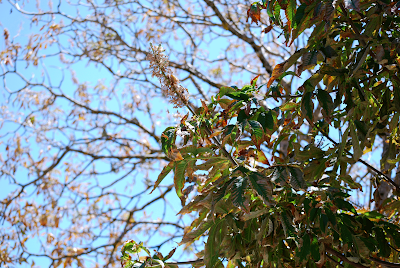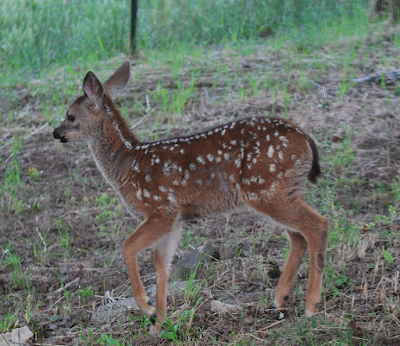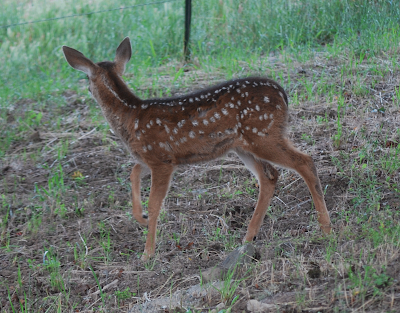The does are bringing their fawns into the farmyard. They are drinking out of the cattle troughs and birdbaths, and eating rogue fruit falling in the old orchard. Their favorite snacks currently are the dropped leaves and flower stalks from the native California buckeye trees.

---
California buckeye tree dropping its leaves in July ---
California buckeye trees have an unusual adaptation to California's dry summer - they are summer deciduous. They drop their leaves in the summer drought period and are the first trees to bud out in the late winter. In the early spring, they are covered with large white blossoms.

---
Dot, a doe ---
I don't believe in feeding wildlife. Feeding wild animals usually leads to conflicts with humans. T
he fed animals may get too close to
humans and start consuming landscape plants
or pets not originally
intended as wildlife food which usually means trouble. They may
wander onto roads where they are hit and killed. The food provided by humans may be nutritionally unbalanced or only available at irregular intervals. Often, a fed wild animal is eventually a dead animal. The
California Department of Fish and Game says it well, "Wild animals don't need your handouts. They need your respect."
As usual, the Dipper Ranch turns my former beliefs on their head. I realize the deer are attracted to the yard partially by the fruit in the orchard, especially since the fruit starts dropping just as the does are ready to bring their fawns out of hiding and introduce them to browsing. I would prefer they leave the fruit for me. I have flashing to put on the trunks of the fruit trees, and this winter, I will be installing a deer fence around my future garden. On the other hand, the fruit trees have been here a long time, maybe 50 years. For much of the last decade, the property was uninhabited by humans or neglected. These very same does probably visited these fruit trees when they were fawns, well before I took up residence in the ranch house.

---
Dot's right ear nick ---
I am trying to teach myself how to identify the deer as individuals and as families. In the next few blogs, I will introduce the local deer families. Today, I would like to introduce you to the Dot Family.

--- Dot's left hip scar ---
DOT - a doe with a black dot on her right side near the top middle of her back. On close inspection, she has a small nick at the 11:00 position on the outside of her right ear. Her left hip is preceded by a small diagonal scar pointing SSE.

--- Dot and the spots on the right side of Dot 1 and Dot 2 ---
Dot has two fawns and I am still trying to tell them apart. Unlike the adults, the fawns don't have scars to readily distinguish them. Recently, I realized not all of their spots are identically arranged, so I'm trying to memorize their individual patterns. This will only work through the summer because they lose their spots when they shed into their winter coats. For now, in the Dr. Seuss fashion, I call the fawns Dot 1 and Dot 2. I first met Dot 1 and Dot 2 in late May while
cursing my brush cutter.

--- Spots on the left side of either Dot 1 or Dot 2 ---
The Dot Family visits the farmyard everyday between 6 and 9 AM and again between 6 and 9 PM. Currently, they are bedding down in the willow thicket below the Ortega corral. Dot 1 and Dot 2 are often within a few feet of each other. I think one might be the leader, foraging ahead of the other and wandering the farthest from the doe. As with all twins, the behavior of one is often attributed to the other. They are curious about
noises and the cat, but will scamper away at any sudden movement towards them.

---
Spots on the left side of the other Dot ---
If you want to see fawns this time of year, I recommend you stake out a California buckeye tree that is dropping its leaves. Settle in a good viewing spot with binoculars about 1/2 hour before dusk. A deer family will likely come by to pick up the leaves that have fallen in the past day. If you are at least 30 feet away and quiet, the deer may freeze at first when you slowly move your binocular hands up to your face, but will probably go back to crunching the dry leaves if you are as still as possible. The new deer families seem to follow a daily routine, so if you spot them once, it might be a good viewing spot for much of the summer.
Next up - Bump and Button.
See also:
Columbian black-tailed deer - Odocoileus hemionus columbianus
California buckeye - Aesculus californica
A couple of hints on how I describe locations on a deer:
- For hour designations or compass directions (11:00 or SSE), imagine the center of the clock or compass is the center of the deer's body as you look at it. Eleven o'clock is to your upper left. SSE stands for south-southeast on a compass or generally to your lower right.
- When referencing the deer's right or left side, it is from the animal's perspective, not the viewer's. Thus, if I say left foreleg, it is the front leg on the left side of the deer, however, if you are facing the deer, that leg will actually be on your right.
Pelmanism is the memory game, also called Concentration, in which you turn up cards and try to match related sets.

 --- Dot, a doe ---
--- Dot, a doe --- --- Dot's right ear nick ---
--- Dot's right ear nick ---




The Other Dot has a sharp right angle corner of spots just above her/his left hip. The First Dot has a much gentler spotted curve... You are lucky to gain such intimacy with them!
ReplyDelete